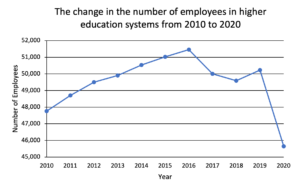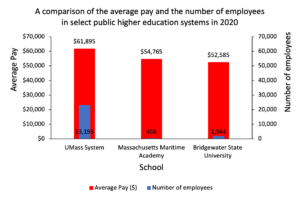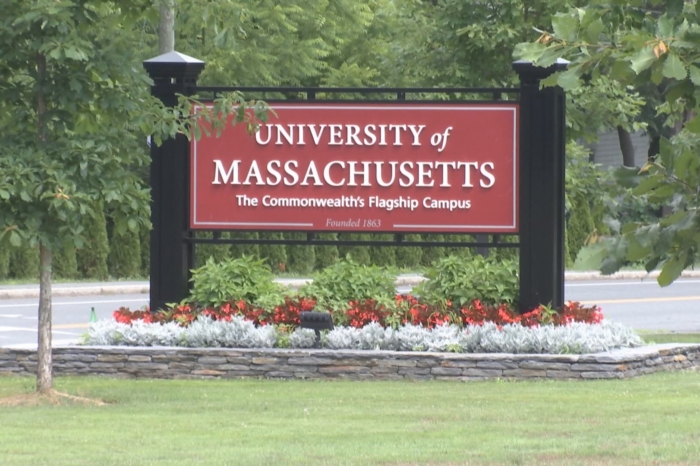A Closer Look at Public Higher Education Employees in Massachusetts
Massachusetts is home to many colleges and universities, both public and private. Over the last 10 years, the average pay of public higher education employees in the Commonwealth has increased by 38.43%. In 2010, the average salary of these employees was $37,827. The average salary increased to $52,363 by 2020.
However, the number of employees in Massachusetts public higher education systems has decreased by 4.43% from 2010 to 2020. In 2010, there were 47,758 higher education employees, and by 2020, there were 45,643 employees. However, this decreasing trend was not consistent across all 10 of these years (Figure 1). Between 2019 and 2020 alone, there was a 9.13% decrease in the number of higher education employees.
 Figure 1. The change in the number of employees in Massachusetts higher education systems from 2010 to 2020.
Figure 1. The change in the number of employees in Massachusetts higher education systems from 2010 to 2020.
Of all of the public higher education institutions in Massachusetts, the University of Massachusetts (UMass) system, Massachusetts Maritime Academy, and Bridgewater State University have the highest paid employees, respectively (Figure 2).

Figure 2. A comparison of the average salary and the number of employees at UMass, Massachusetts Maritime Academy, and Bridgewater State University in 2020.
Most of the highest paid employees in public higher education institutions are in the UMass System. In 2020, the highest paid public employee in Massachusetts was Michael Collins, chancellor and senior vice president of health sciences at UMass Medical School, with a salary of $1,108,748. Collins is the longest-tenured chancellor ever at UMass Medical.
The next highest paid employee was the executive deputy chancellor provost dean of the UMass School of Medicine, who earned $1,070,736 in 2020.
In 2020, the UMass head basketball coach earned the third highest salary in public higher education with a salary of $850,750. However, this impressive salary does not compare to those of coaches of larger sports programs across the country. For example, the coaches of Clemson football and University of Kentucky men’s basketball each make a whopping $9.3 million a year. These coaches make nearly 8.5 times more than the chancellor and senior vice president of health sciences at UMass Medical School.
It will be interesting to assess the data for 2021, once it becomes available, since the 2020 data accounts for anybody employed in the higher education system at the beginning of 2020 (before the COVID-19 pandemic started in March 2020). The data from 2021 will provide a clearer picture to how the pandemic may have had an impact on the number of higher education employees and their salaries.
During the pandemic, 800 positions were eliminated and 3,000 employees furloughed in the UMass system alone as of July of 2020. However, Charlie Baker also administered $500 million from the Governor’s Emergency Education Relief Fund in July 2020 for Massachusetts schools and colleges. To better understand the effects of these COVID-driven actions, the data from 2021 must be compared to data from previous years.
About the Author: Emily Donovan is a Roger Perry Government Transparency Intern at Pioneer Institute for the summer of 2021. She is a rising senior studying Animal Behavior at Bucknell University.



